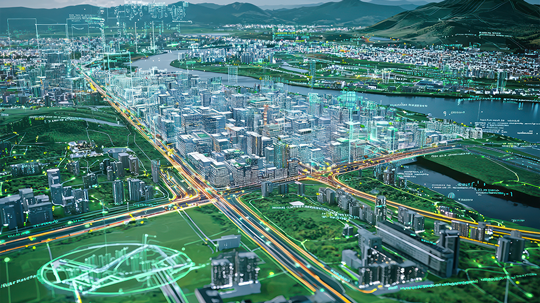
The potential of the ‘digital twin’ for sustainable and climate-adapted urban development
- Project team:
Marlène de Saussure (Project manager), Sonja Kind, Tobias Hungerland, Susann Bernhold
- Thematic area:
- Topic initiative:
Committee on Housing, Urban Development, Building and Local Government
- Analytical approach:
TA-Kompakt
- Startdate:
May 2025
- Enddate:
2026
sprungmarken_marker_4789
Thematic background
A digital twin is a virtual copy of a physical object, infrastructure or process in the real world or a planned project. This digital replica consists of data-based models that mimic the functions and properties of the original using artificial intelligence (AI) or alternate reality-based simulations and algorithms. Digital twins enable experiments that go beyond the conventional functions of the analogue object. Digital twins allow real-world structures to be developed proactively, tested as needed, and optimised.
This technology is already being applied in urban planning: streets, building complexes and city dwellers are digitally replicated and brought into interaction to enable the simulation and planning of integrated, efficient infrastructure. Complex and diverse data on built structures, physical properties and dynamic movement systems in cities or neighbourhoods are analysed in 3D models.
In Germany, a large number of pilot and research projects focus on the application of urban digital twins. The German Federal Government's Smart Cities Model Projects funding programme (Federal Ministry of Housing, Urban Development and Building) currently supports 49 projects for the development and practical implementation of digital twins in German municipalities and districts (as of May 2025). A key project in this programme is the knowledge transfer and city partnership project 'Connected Urban Twins', focusing on topics such as urban climate, traffic flow and infrastructure. This project involves Hamburg, Munich and Leipzig. The University of Stuttgart (HLRS) has developed digital twins of the cities of Herrenberg (Baden-Württemberg) and Stuttgart's Marienplatz to inform planning measures for the energy transition and analyse the traffic situation from the perspective of pedestrians and cyclists respectively.
However, there are currently regulatory gaps and challenges in the use of digital twins for sustainable urban planning, particularly with regard to data protection and security. There are no clear, uniform regulations on how data may be collected, stored and processed to protect citizens' privacy and ensure data security. Additionally, there are no widely accepted standards for creating and using digital twins. This complicates interoperability between different systems and software solutions, which can hinder cooperation between cities and different stakeholders. Clear legal regulations are also needed regarding the responsibilities of the various stakeholders and liability in the event of errors or accidents caused by simulations. Despite financial support from sources such as the Smart Cities funding programme, long-term financing and the provision of the necessary resources for digital twins are often uncertain. Many cities find it difficult to make the necessary investments and finance projects sustainably. Finally, there is often a lack of effective and transparent mechanisms to involve citizens in the planning process.
Objective and approach
The compact TA Study on the potential and societal impacts of urban digital twins investigates the ecological added value of using digital twins in urban planning. The following key questions will be addressed:
- Which areas of urban development are particularly suitable for the application of digital twins to increase resource efficiency?
- What examples of applications already exist that have been tested in practice and proven effective?
- How can digital twins be used to generate the data required for effective climate adaptation concepts (e.g. air quality, cooling effects and building performance)?
In addition, structural and urban planning policy issues play an important role, including:
- To what extent can a digital twin contribute to improved risk management in the event of weather incidents, major accidents or terrorist attacks?
- How can regulations for the generation and processing of data for digital twins of urban infrastructures be developed?
- What application guidelines and legal framework conditions are necessary for the optimal operationalisation of digital twins?
- What financing models are conceivable for the development and implementation of simulation technologies?
- What participatory and collaborative approaches can be pursued with the help of digital twins to promote citizen participation?
The study consists of three phases:
- On the basis of desk research, reports, studies and scientific publications on the application of digital twins in urban planning will be evaluated as part of a literature and source review. This will identify examples of existing applications and emerging innovations.
- In a second phase, interviews will be conducted with relevant stakeholders from urban development policy, digital twin technology providers and the planning industry to validate the literature analysis findings and identify unaddressed topics.
- In a third phase, participatory formats such as interdisciplinary expert workshops and surveys will be used to discuss the results obtained so far and develop consensus-based action plans.
